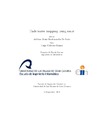Identificador persistente para citar o vincular este elemento:
https://accedacris.ulpgc.es/jspui/handle/10553/14532
| Campo DC | Valor | idioma |
|---|---|---|
| dc.contributor.advisor | Cabrera Gámez, Jorge | - |
| dc.contributor.author | Sarrionandia De León, Aridane Jesús | - |
| dc.contributor.other | Escuela de Ingeniería Informática | en_US |
| dc.date.accessioned | 2015-10-08T02:30:14Z | - |
| dc.date.accessioned | 2018-06-05T07:51:57Z | - |
| dc.date.available | 2015-10-08T02:30:14Z | - |
| dc.date.available | 2018-06-05T07:51:57Z | - |
| dc.date.issued | 2015 | en_US |
| dc.identifier.uri | https://accedacris.ulpgc.es/handle/10553/14532 | - |
| dc.description.abstract | El proyecto contiene módulos de simulación, procesado de datos, mapeo y localización, desarrollados en C++ utilizando ROS (Robot Operating System) y PCL (Point Cloud Library). Ha sido desarrollado bajo el proyecto de robótica submarina AVORA.Se han caracterizado el vehículo y el sensor, y se han analizado diferentes tecnologías de sensores y mapeo. Los datos pasan por tres etapas: Conversión a nube de puntos, filtrado por umbral, eliminación de puntos espureos y, opcionalmente, detección de formas. Estos datos son utilizados para construir un mapa de superficie multinivel. La otra herramienta desarrollada es un algoritmo de Punto más Cercano Iterativo (ICP) modificado, que tiene en cuenta el modo de funcionamiento del sonar de imagen utilizado. | en_US |
| dc.description.abstract | The developed project contains simulation, data processing, mapping, and location, developed in C++ using ROS (Robot Operating System) and PCL (Point Cloud Library). The project has been developed under the underwater robotics project AVORA. The vehicle and sensor itself are characterised, and different mapping technologies are analysed. For the processing stages modules for conversion to point cloud, thresholding, outlier removal, and shape detection have been developed. All this data is transferred to the mapping module, which builds a multi-level surface map. The other developed tool is an algorithm based on the ICP (Iterative Closest Point) algorithm, modified to estimate transformation between point clouds transformed due to the way the imaging sonar acquires data, which is emitting beams at discrete jumps. | en_US |
| dc.format | application/pdf | es |
| dc.language | spa | en_US |
| dc.rights | by-nc-nd | es |
| dc.subject | 120317 Informática | en_US |
| dc.subject.other | Sonar | en_US |
| dc.subject.other | Gazebo | en_US |
| dc.subject.other | ROS | en_US |
| dc.subject.other | PCL | en_US |
| dc.subject.other | Multi level surface maps | en_US |
| dc.subject.other | Iterative closest Points | en_US |
| dc.subject.other | ICP | en_US |
| dc.title | Underwater mapping using sonar | en_US |
| dc.type | info:eu-repo/semantics/studentThesis | en_US |
| dc.type | StudentThesis | en_US |
| dc.compliance.driver | 1 | es |
| dc.contributor.departamento | Departamento de Informática y Sistemas | en_US |
| dc.contributor.facultad | Escuela de Ingeniería Informática | en_US |
| dc.identifier.absysnet | 714063 | es |
| dc.investigacion | Ingeniería y Arquitectura | en_US |
| dc.rights.accessrights | info:eu-repo/semantics/openAccess | es |
| dc.type2 | Proyecto fin de carrera | en_US |
| dc.utils.revision | Sí | en_US |
| dc.identifier.matricula | TFT-28987 | es |
| dc.identifier.ulpgc | Sí | en_US |
| dc.contributor.buulpgc | BU-INF | en_US |
| dc.contributor.titulacion | Ingeniero en Informática | es |
| item.grantfulltext | open | - |
| item.fulltext | Con texto completo | - |
| crisitem.advisor.dept | GIR SIANI: Inteligencia Artificial, Robótica y Oceanografía Computacional | - |
| crisitem.advisor.dept | IU Sistemas Inteligentes y Aplicaciones Numéricas | - |
| crisitem.advisor.dept | Departamento de Informática y Sistemas | - |
| Colección: | Trabajo final de grado | |
Visitas
355
actualizado el 27-sep-2025
Descargas
1.369
actualizado el 27-sep-2025
Google ScholarTM
Verifica
Comparte
Exporta metadatos
Los elementos en ULPGC accedaCRIS están protegidos por derechos de autor con todos los derechos reservados, a menos que se indique lo contrario.
